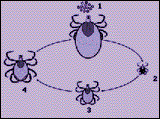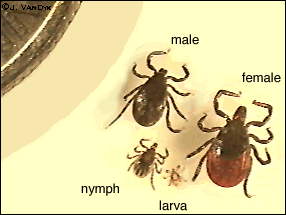 Ticks are relatives of spiders, scorpions, and mites. As such, their survival is dependent on a host (i.e., they're parasites). Specifically, ticks feed on an animal's blood or body fluids. The deer tick (Ixodes scapularis in the East & Midwest, and Ixodes pacificus in the West) goes through many stages during its lifecycle, and feeds on different species at each point.
Ticks are relatives of spiders, scorpions, and mites. As such, their survival is dependent on a host (i.e., they're parasites). Specifically, ticks feed on an animal's blood or body fluids. The deer tick (Ixodes scapularis in the East & Midwest, and Ixodes pacificus in the West) goes through many stages during its lifecycle, and feeds on different species at each point.
Ticks begin as eggs (stage 1) that hatch into 6-legged larvae (stage 2).
Larvae live and feed on animals (mice, deer, squirrels, livestock, and any humans who enter the tick habitat) for about a week before detaching then molting (shedding) anywhere from 1 week to 8 months later.
The larvae then become 8-legged nymphs (stage 3). Nymphs feed on animals, engorge for 3 to 11 days, detach, and molt about a month later (depending on the species and environmental conditions).
Once the nymph molts, it becomes an adult tick (male or female). Ticks climb up grass and plants and hold their legs up "sensing" and "looking" for their prey. Ticks are attracted to their hosts by detecting carbon dioxide and heat through special organs located on the first pair of the tick's legs (Haller's organs). When a warm-blooded animal walks past, the tick can crawl onto them and begins feeding. Ticks insert their mouths, attach to their prey, and engorge themselves with a blood meal (stage 4). During feeding, tick saliva can get into the host's body and blood stream. Any tick infected with Borrelia burgdorferi can then inadvertently spread this bacteria to the host.
Male and female ticks usually mate while attached to the host. A few weeks later, the engorged female detaches from the host and lays her eggs (1000 - 8000 eggs) on a leaf. A tick usually lives a year before dying.
(L to R) larva, nymph, adult male, adult female, engorged female

